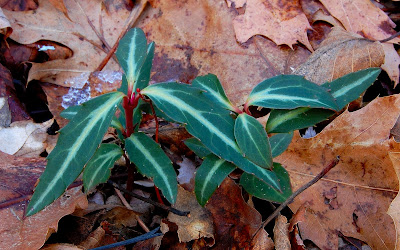Photo taken in September in northcentral Indiana. Good luck, and happy new year!
********************
Too easy, I guess. Keith quickly correctly identified the plant above as Solidago flexicaulis. Nice call, Keith!

Good call, Scott! It is Viola pedata, Birdfoot Violet, a denizen of the dry country. It's especially at home in dry sand among a thin growth of Black Oak and Sassafras in the northern third of Indiana. Charles Deam also found it on sandstone ridges in a few counties along the southern edge of the state.
Birdfoot Violet at Ober Savanna Nature Preserve, Starke County, Indiana

The winter leaves are markedly different than those of the growing season. In winter, the leaves are coriaceous (thick and leathery), on very short petioles, usually very purple, and the lobes are short and wide. New leaves emerge in spring with long and very narrow lobes. Here's a photo of purple winter leaves and the old, withered leaves lying on the ground.



Good call, "Euphorb!" It is Epigaea repens, Trailing Arbutus. At home on acid slopes, this tiny native shrub stays green all winter and flowers in April and May. The flowers emit a very strong, very attractive spicy fragrance that can be detected from a distance. Look for it on the steepest slopes, especially cool north and east-facing ones where mosses are abundant. A photo of this plant in flower is posted below.


 The french fur trappers who came through the Great Lakes region called this delightful little subshrub Petit the de bois meaning "little tea of the woods." It's the plant we know as Wintergreen or Teaberry, Gaultheria procumbens, and it has an enjoyable wintergreen flavor and aroma. Find a forest with sandy, acid soil and this tiny shrub is a possibility. It's one of several native plants that stay green all winter and add color to the winter landscape.
The french fur trappers who came through the Great Lakes region called this delightful little subshrub Petit the de bois meaning "little tea of the woods." It's the plant we know as Wintergreen or Teaberry, Gaultheria procumbens, and it has an enjoyable wintergreen flavor and aroma. Find a forest with sandy, acid soil and this tiny shrub is a possibility. It's one of several native plants that stay green all winter and add color to the winter landscape.



